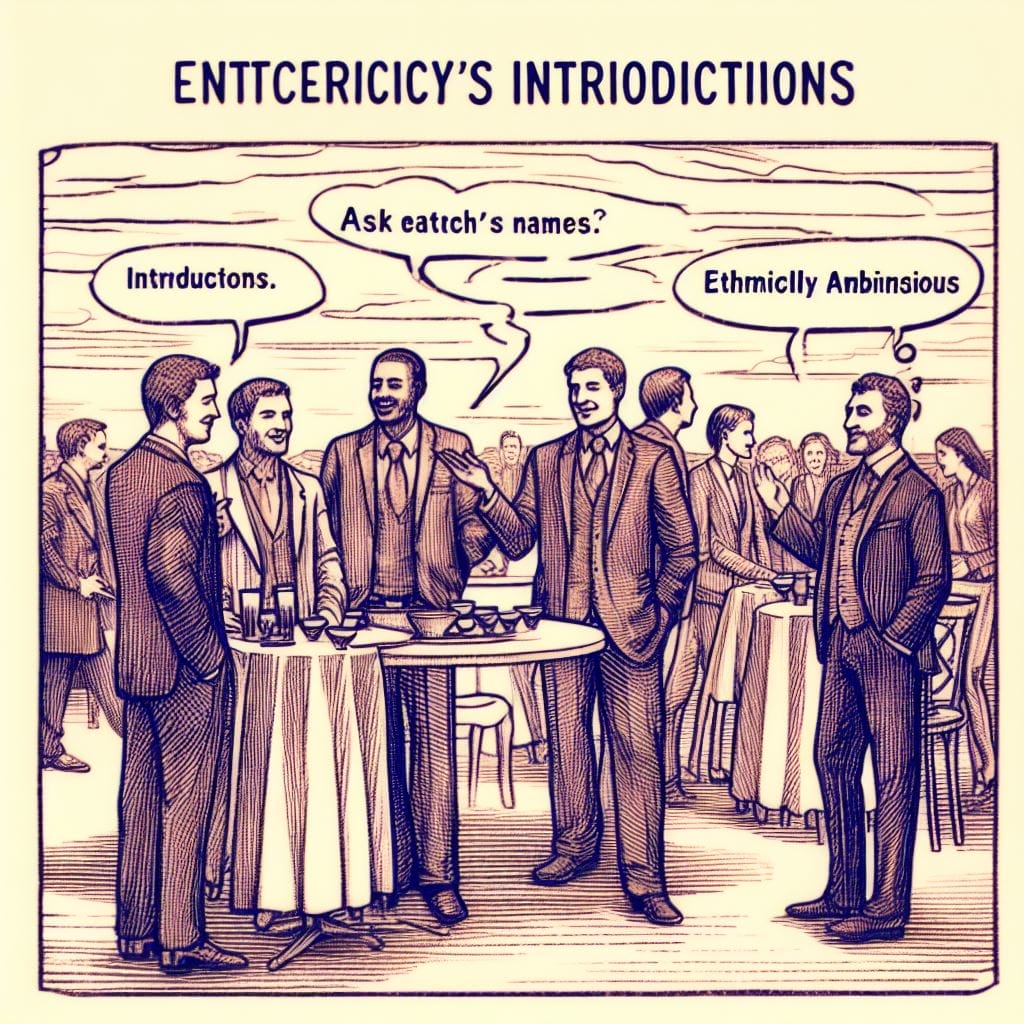Introduction
In the symphony of social interactions, the opening note is often a simple yet powerful question: “What’s your name?” As someone who values the art of introductions, the way you answer can set the rhythm for a harmonious exchange. Picture this: someone asks your name, and the stage is yours to respond. How do you navigate this moment, shaping a response that is not only polite and formal but also uniquely you? So today in this guide you will get the answer to the question ‘ How Do You Respond When Someone Asks Your Name? in detail.
Join me as we delve into the delightful dance of introductions, exploring ways to respond with a genuine flair, making it not just an answer but the beginning of a captivating conversation.
So, the next time someone asks, “What’s your name?” let’s craft a response that transforms a mere formality into a delightful exchange—because every introduction is a chance to share a bit of yourself, making it a nice moment to meet and greet.
Key Takeaways
After immersing yourself in the intricate world of introductions, our blog equips you with a treasure trove of insights and strategies.
- Master the power of a genuine smile to convey warmth and approachability in introductions.
- Explore classic approaches, emphasizing the importance of projecting confidence when stating your name.
- Initiate small talk beyond names, utilizing open-ended questions for engaging conversations.
- Infuse creativity into your responses, using playful alternatives like nicknames or sharing fun facts about yourself.
- Learn strategies for handling difficult-to-pronounce names gracefully, fostering a culture of respect and understanding.
- Navigate cultural sensitivities and etiquettes, recognizing the importance of cultural understanding in response to name inquiries.
- Adapt to online interactions, striking a balance between professionalism and approachability in virtual settings.
- Discover the potential for meaningful connections and positive first impressions by thoughtfully responding when someone asks for your name.

The Power of a Genuine Smile
In the intricate dance of human interaction, a genuine smile emerges as a powerful conductor, silently orchestrating the symphony of first impressions. Let’s delve into the nuances of this universal language and explore how it influences our encounters.
The Silent Language of Body: A Prelude to Connection
“The body says what words cannot.” – Martha Graham
When words falter, body language takes center stage. Imagine yourself walking into a room and seeing a stranger eye to eye. What has a greater impact than words? Your body language. The way you carry yourself, the subtleties of your posture, and the genuine warmth of your smile—are all crucial elements in this non-verbal overture.
Showcasing Warmth: The Smile That Speaks Volumes
In the tapestry of introductions, a smile is a thread that stitches together warmth and approachability. It’s the silent envoy that whispers, “I’m friendly, and I’m open to connection.” But how does one master the art of a genuine smile?
Tips for Crafting the Perfect Smile
- Eye Contact: When you meet someone new, lock your eyes for a moment. It conveys sincerity and establishes a connection beyond words.
- Naturalness Reigns: A forced smile can be detected from a mile away. Let it be genuine, reflecting the joy of the moment.
- Confidence in Grin: Confidence adds allure to your smile. It signifies self-assuredness and sets a positive tone for the encounter.
Recall that a smile has its language and is more than just an expression.
The Classic Approach: State Your Name
Transitioning from the silent language of smiles, let’s explore the classic approach of stating your name—a timeless ritual in the realm of introductions.
A Name, A Confidence Statement
“What does a name mean? The thing we refer to as a rose by each distinct name may smell just as wonderful. — William Shakespeare
Indeed, a name holds significance, serving as a tag for your identity. How you articulate it can significantly impact the listener’s perception.
Tips for a Confident Name Revelation
- Clarity in Pronunciation: Enunciate each syllable clearly, ensuring your name dances gracefully off your tongue.
- Confidence is Key: Project confidence in your voice. It adds a layer of assurance to your introduction.
- Mitigate Misunderstandings: Anticipate potential stumbling blocks in pronunciation and address them proactively. It’s all about smooth communication.
Adding a Dash of Humor: Breaking the Ice
In the unpredictable dance of human interaction, humor emerges as the perfect dance partner. Injecting a touch of wit into your introduction can transform a potentially awkward situation into a memorable exchange.
Creating Humorous Reactions: Handling the Uncomfortable
“The shortest distance between humans is laughter.” — Victor Borge
Consider the following instance: “What’s your call?” is a question that someone asks you at the party. Embrace the opportunity to infuse humor into the exchange.
Best Responses to Common Situations
- The Nickname Twist: “Well, my friends call me Rocket because I’m always ready for liftoff! But you can stick with [Your Name].”
- The Awkward Pronunciation Joke: Hi “My name is like a tongue twister, but I’ve been practicing. Drumroll, please… [Your Name]!”
- The Contextual Quip: “In a parallel universe, I’m known as [Playful Alter Ego], but in this reality, I respond to [Your Name].”
Remember, humor is a universal language that transcends barriers.
Name Response Playbook: Navigating Every Situation with a Handy Table
| Situation | Response | Example |
|---|---|---|
| Casual Introduction | Hey there! I’m [Your Name]. | “Hey there! I’m Jake.” |
| Formal Setting | Nice to meet you. I’m [Your Name]. | “Nice to meet you. I’m Sarah.” |
| Adding a Friendly Touch | They call me [Your Nickname]. | “They call me Alex.” |
| Inquisitive Follow-up | And you? What do they call you? | “And you? What’s your go-to name?” |
| Playful Option | You can call me [Fun Nickname]. | “You can call me Sparky.” |
| Mysterious Vibe | Some call me [Alias]. | “Some call me Shadow.” |
| Humorous Twist | I respond to anything but usually [Quirky Name]. | “I respond to anything, but usually, I’m Captain Chaos.” |
| Cultural Reference | Back home, they know me as [Cultural Name]. | “Back home, they know me as Luna.” |
| Expressing Interest in Their Name | Before I forget, what’s your name? | “Before I forget, what should I call you?” |
| Creating Rapport | Names are fascinating, don’t you think? I’m [Your Name]. | “Names are fascinating, don’t you think? I’m Max.” |
| Acknowledging Commonality | Funny enough, my name is [Common Name] too. | “Funny enough, my name is Taylor too.” |
| Professional Setting | I go by [Your Full Name] in professional circles. | “I go by Dr. Smith in professional circles.” |
| Using Initials for Formality | Professionally, it’s [Initials]. | “Professionally, it’s J.R.” |
| Emphasizing Pronunciation | It’s [Your Name], pronounced [Phonetic Pronunciation]. | “It’s Elena, pronounced eh-lay-na.” |
| When They Mispronounce Your Name | You’re close! It’s [Correct Pronunciation]. | “You’re close! It’s Ah-melia, not Ah-maylia.” |
| Sharing a Meaningful Fact | My name means [Meaning], by the way. | “My name means ‘grace,’ by the way.” |
| Using Surname Only | Just [Surname], thanks. | “Just Smith, thanks.” |
| Creating a Connection with Last Name | My last name is [Last Name], like [Famous Person]. | “My last name is Lennon, like John Lennon.” |
| Being Spontaneously Creative | Today, I’m feeling like a [Random Fun Name]. | “Today, I’m feeling like a Stellar Nova.” |
| Turning the Question Around | Interesting question! What’s your name? | “Interesting question! What should I call you?” |
| Being Enigmatic | Names hold secrets, but you can call me [Mystery]. | “Names hold secrets, but you can call me Cipher.” |

Initiating Small Talk: Beyond the Basics
The Importance of a Warm Greeting
When it involves small communication, the primary effect is frequently the lasting one. A simple “howdy” can set the tone for a pleasing verbal exchange. But how do you move beyond the standard niceties? Let’s explore.
Navigating Beyond Names
What’s your name?” – the quintessential small talk starter. While it’s a valid question, initiating a conversation with it every time can become monotonous. People regularly need to understand more approximately you than just your call. So, how do you resolve this without sounding like a damaged file?
Answering with Engaging Openers
Consider this scenario: you meet someone new, and instead of the usual response, you throw in a curveball. “Hey there, funny story – people often call me by my middle name, but you can call me the ‘Master of Puns.’ What about you?” This not only breaks the ice but opens the door to a more engaging exchange.
The Value of Inquiry-Based Questions
Small speak evolves while you ask questions that invite more than a one-phrase response. “What do you experience doing for your loose time?” or “Tell me approximately the closing e-book that captivated your interest.” These questions invite the alternative individual to proportion extra about themselves, making the conversation richer and extra significant.
The Foundation of Meaningful Connections: Active Listening
Small communication isn’t pretty much talking; it’s similarly approximately listening. Actively taking note of the opposite man or woman’s responses demonstrates authentic interest and creates a connection that goes past superficial exchanges. Remember, it’s not pretty much hearing phrases; it’s approximately information the individual at the back of them.
Introducing Creativity: Going Beyond the Typical
Going Above and Beyond Disclosing Your Creative Side
Small communication doesn’t need to be an earthly trade of pleasantries. Injecting creativity into your responses can make the communique memorable and exciting. Consider those processes:
Playful Alternatives to Names
When asked for your name, why not add a dash of playfulness? “Nice to meet you! I’m the ‘Coffee Connoisseur,’ but friends call me Joe. And you?” This no longer simply introduces a hint of humor but also gives the opposite person a glimpse into your persona.
Determining Context for Proper Reactions
Creativity should always be tempered with sensitivity to the context. While a witty response might be fitting among friends, a more reserved setting may call for a different approach. Being attuned to the atmosphere ensures your creativity enhances, rather than disrupts, the flow of conversation.
Keeping it Professional
In certain conditions, retaining a professional demeanor is critical. Especially in a company setting, where first impressions can drastically affect relationships, it’s important to balance creativity with an experience of professionalism.
Handling Difficult-to-Pronounce Names
Addressing the Challenges
Embracing the Quirks
When confronted with a name that defies traditional phonetics, it’s essential to method it with open thoughts and a sense of humor. Funny answers can be an effective tool, right away breaking the ice and developing a lighthearted atmosphere. Instead of feeling burdened by the weight of mispronunciations, view them as opportunities for connection through laughter.
Real Name, Real Connection
The authenticity of a real name is an integral part of one’s identity. While it may be tempting to adopt an easier-to-pronounce alias, the true essence of self lies in sharing your genuine name. Exploring the phonetic nuances of your name not only educates others but also strengthens the bonds of understanding.
Techniques for Achievement
- Answer the Question: When faced with the inevitable “What’s your name?” query, respond with clarity and self-belief. A direct answer ensures that the conversation proceeds smoothly.
- Would Probably: In situations where individuals are uncertain about the pronunciation, employing phrases like “It would probably sound like…” provides a friendly and approachable entry point for dialogue.
- Handling Mispronunciations Gracefully: The key is to keep things light. A nicely timed comic story or a mild correction with a smile can diffuse any awkwardness and create a fine interaction.

Cultural Sensitivity and Etiquette: Nurturing Global Understanding
Importance of Cultural Understanding
In a world where diversity is a celebrated virtue, cultural sensitivity is paramount. When responding to inquiries about one’s name, acknowledging and appreciating cultural differences fosters a respectful and inclusive environment.
Navigating Cultural Norms
Understanding the cultural norms and practices surrounding names is a fundamental aspect of fostering cultural sensitivity. In some cultures, addressing someone by their full name signifies formality and respect, while in others, a first-name basis is the norm. Being aware of these nuances prevents unintentional offenses.
Tips for Harmonious Interactions
- Ask a Question: In situations where you encounter a name from a different cultural background, expressing curiosity by asking questions can be a bridge to deeper understanding. People appreciate the genuine interest in their cultural identifiers.
- People Know, People Call: Acknowledge that people might call you by a name that is more familiar to their pronunciation. While correcting them is acceptable, it’s essential to do so with tact and patience.
- Would Answer: When met with questions about one’s name, responding in a manner that educates and enriches the conversation ensures a positive interaction. Share the significance of your name and its cultural roots.
Navigating Online Interactions
The Virtual Paradigm Shift
Embracing Change
In the era of virtual interactions, the once-familiar handshake has given way to the click of a keyboard. As we navigate this shift, the art of introducing oneself online becomes a crucial skill. It’s not just about sharing your name; it’s about crafting a virtual persona that resonates.
From Funny Answers to Thoughtful Responses
In the world of online introductions, a funny answer can be the key to breaking the ice. When someone pops the undying question, “What’s your name?” bear in mind responding with a touch of humor. A properly timed funny story not only effectively eases tension but also leaves a memorable impact.
Mastering the Virtual Introduction
1. Answer the Question, Add a Twist
When posed with the classic “What’s your name?” query, go beyond the expected. Inject a twist into your response, making it not just informative but also engaging. For instance, “I go by Mary, but you can call me the Queen of Puns.”
2. Ask a Question in Return
Engage in a reciprocal dialogue by turning the spotlight back on the questioner. Asking, “And you, what name do you go by in these digital realms?” creates a conversational flow, fostering a sense of connection.
3. Weird and Wonderful Introductions
In the vast landscape of online interactions, don’t shy away from the weird and wonderful. Embrace the opportunity to stand out by sharing a quirky fact or a peculiar nickname. After all, being memorable is the first step to building a virtual rapport.
Striking the Right Tone
Professionalism vs. Approachability
Balancing professionalism and approachability is an art form. While a virtual setting allows for a more relaxed tone, maintaining a level of professionalism is essential. Strive for an approachable demeanor without sacrificing the gravity of your online presence.
A Personal Journey through Authenticity and Connection
In the realm of introductions, my journey has been a tapestry woven with threads of authenticity and a touch of creative flair. As someone who cherishes the power of a warm smile, I’ve often found that this simple gesture sets the stage for a positive interaction. Navigating various social situations, I’ve come to appreciate the importance of projecting confidence when stating my name—a classic approach that never loses its charm.
One memorable experience involved infusing creativity into my introduction during a team-building event. Rather than a traditional name exchange, we were encouraged to share a quirky fact about ourselves. This not only sparked engaging conversations but also made the introductions memorable and light-hearted.
Handling a name that’s often mispronounced, I’ve learned to gracefully correct and guide others, fostering an environment of respect and understanding. This experience fueled my belief in the power of cultural sensitivity, recognizing that names are not just words but carriers of identity and heritage.
As our world increasingly transitions to virtual spaces, adapting my approach to online interactions has become crucial. Balancing professionalism with approachability, I’ve found that a well-crafted online introduction can set the tone for positive digital engagements.
In conclusion, the art of introducing oneself is a continuous journey of self-expression and connection. My experiences have taught me that every introduction is an opportunity to share a bit of my story, fostering meaningful connections in diverse settings. I invite you to embark on your journey, experiment with various approaches, and witness the magic that unfolds when you respond thoughtfully to that simple yet powerful question: “What’s your name?”

FAQs: How Do You Respond When Someone Asks Your Name?
How do you consciously answer when someone you’ve just met for the first time asks your name? What might be the best way to share this information in a friendly yet formal manner?
A heterogeneous group of people politely conversed, demonstrating a peaceful interchange of ideas despite differences in religion. People from different origins and nationalities talk about what to say if someone forces their religion on you.
In more relaxed settings, like casual meet-ups, how might you incorporate humor or a joke when someone asks your name? What are some nice-to-meet-you moments that stand out in a lighthearted conversation?
In more relaxed settings, like casual meet-ups, I often depend on humor to make the interaction memorable. If someone playfully asks my name, my comeback might be, “Well, you can call me the mystery person!” It’s a light-hearted way to handle the situation and escalate the conversation into a more enjoyable exchange.
People whose names are sometimes hard to remember, like Mary, often face a unique challenge. How can one navigate introductions when someone asks their name in a way that ensures it’s both memorable and easy to recall?
When dealing with the forgettable name dilemma, especially for people whose names might not be as commonly known, like Mary, I’m conscious of making introductions efficient yet memorable. I might say, “I’m [Name], and just like Rachel, everyone knows a lovely Mary!” It adds a personal touch and helps people recall my name more easily.
Occasionally, someone might ask your name peculiarly or unexpectedly. How do you respond to such strange scenarios while maintaining the flow of the conversation and leaving a positive impression?
Occasionally, when faced with strange queries about my name, my approach is to remain comfortable and escalate the conversation positively. If someone asks unexpectedly, I might respond with, “I’m [Name], and my name called by a cashier once caused quite the laughter!” It lightens the situation and keeps the interaction flowing smoothly.
When intending to introduce yourself in a more formal setting, what are the best responses that strike a balance between formality and a warm, nice-to-meet-you approach? How can one ensure a courteous introduction in professional or official environments?
When introducing myself in a more formal place, I’m conscious of putting stability among formality and friendliness. “Hello, my call is [Name], and I’m here to effectively percentage my expertise on this professional placing,” I would say. Glad to have met you! It sets a courteous tone without making the interaction uncomfortable.
Conclusion: How Do You Respond When Someone Asks Your Name?
In the delightful journey of mastering the art of introducing yourself, we’ve unraveled the nuances that transform mere formality into meaningful connections. From the warm embrace of a genuine smile to navigating the intricacies of online interactions, you now hold a repertoire of techniques to respond thoughtfully when someone asks your name.
As you reflect on the dance of introductions, remember that each “nice to meet you” is an opportunity to share a piece of your story. By incorporating the power of creativity, navigating cultural nuances, and fostering genuine connections, you elevate introductions from routine to remarkable.
So, as you step into the world armed with newfound insights, go ahead—paint your introductions with authenticity and warmth. Embrace the diversity of names and experiences, for in each introduction lies the potential for a unique and memorable connection.
Engage with the world with confidence, share your story, and let every introduction be a chapter in the ongoing narrative of your life.
Call to Action:
Ready to put these insights into practice? The next time you introduce yourself, experiment with a creative twist or employ a small talk strategy. Share your experiences and newfound skills in the comments below. Let’s create a space where introductions are not just exchanges but opportunities to celebrate the richness of human connection!

Sarah Andrews’ work on relationships is informed by a breadth of experience and a strong interest in human nature. Sarah, who holds a Psychology degree and has a good eye for nuances, delves into the complexity of communication and emotion, delivering insightful insights for readers seeking personal growth and emotional pleasure. Sarah hopes that her empathic approach and insightful suggestions will motivate readers to understand themselves and their relationships better.
